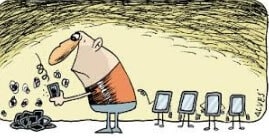Geography Activity, suitable for students in the ninth year of elementary school, with exercises to understand the text.
This geography activity is available for download in an editable Word template, ready to print in PDF and also the completed activity.
Download this activity from:
SCHOOL: DATE:
PROF: CLASS:
NAME:

The measure taken to promote the movement of the economy, in a totally desperate act by the manufacturers at the time, was strategically shorten the life cycle of products, in order to ensure continuous consumption through the dissatisfaction of consumers.
This practice, called Scheduled Obsolescence, basically applies every time manufacturers produce one or several products that, artificially, have, in some way, their durability decreased than originally wait. As a result, consumers are forced to discard purchased products in a much shorter period and replace them with new ones.
This endless cycle of consumption ends up becoming a serious problem, and not just for Brazilian consumers. The increase in electronic and toxic waste, as well as the lack of clear information on how to dispose of it of these obsolete products, has impacted the environment and the quality of life of the world population throughout the years old.
Currently, the world population consumes around 30% more than the planet can support and replace. Allied to this fact, there is still a need to reduce the emission of gases from the greenhouse effect by more than 40%, so that the global temperature does not increase by more than two degrees Celsius. 
It is noteworthy, at this point, that the protection of the environment is a mission of the entire community, including being supported by our Constitution Federal in its article 225, caput, which states that "everyone has the right to an ecologically balanced environment, a good for common use by the people and essential to a healthy quality of life, imposing on the Public Power and the community the duty to defend and preserve it for present and future generations.”.
Law 12,305, of August 2, 2010, which instituted the National Solid Waste Policy, created based on the aforementioned article 225 of the Federal Constitution, also provides basic principles and objectives that try to ensure the protection of the environment, including reinforcing in its articles 30 to 33 shared responsibility between the Government, product suppliers and consumers, on the life cycle of products, their packaging and the correct way to dispose of batteries, tires, oils, lamps, electronic products and other components, in order to avoid not only Programmed Obsolescence, but also the correct handling of all waste and its due recycling.
Allied to the environmental aspect, we also find support in the Consumer Defense Code, which provides, as a basic consumer right, the right to education and dissemination about the proper consumption of products and services (art. 6, II, CDC), as well as the right to adequate and clear information (art. 6, III, CDC), in order to ensure that consumers are fully aware of all the characteristics of the product, including its durability and manner correct disposal, in order to guarantee full freedom of choice for consumers in the act of purchasing such products, balancing, in the end, the relationship of consumption.
(…) The harm that Programmed Obsolescence brings to consumers' lives is demonstrated in a crystalline way in these cases. In front of this picture,
http://www.idec.org.br/em-acao/artigo/um-mal-a-ser-combatido-a-obsolescencia-programada
1) What is Scheduled Obsolescence?
2) When and why was this term created?
3) Why, according to the text, is the infinite consumption cycle of disposable products a problem for consumers?
4) According to the text, protecting the environment is whose mission? Explain.
5) What institutes law 12,305, of August 2, 2010? What was it created for?
6) "The consumer purchases, in good faith, a product and, within the warranty period, it already has defects, not reaching its intended purpose, what should the consumer do? Where should the consumer seek support in this situation?
7) What does the Consumer Protection Code provide as a basic consumer right?
8) Given this situation, and according to the text, what needs to be done in our country to improve this situation?
9) Complement the studies on the subject by watching the videos:
https://www.youtube.com/watch? v=jJALBPHFvV4 The history of things.
https://www.youtube.com/watch? v=5tKuaOllo_0 The Secret History of Planned Obsolescence
By Rosiane Fernandes Silva
At answers are in the link above the header.
 report this ad
report this ad